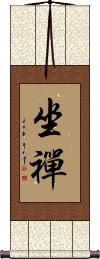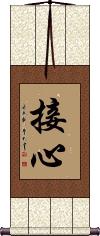Many custom options...
And formats...

Zazen in Chinese / Japanese...
Buy a Zazen calligraphy wall scroll here!
Personalize your custom “Zazen” project by clicking the button next to your favorite “Zazen” title below...
Sit in Meditation
Zazen
坐禪 describes the act of sitting in a state of deep meditation.
You'll notice that the second character is Chan/Zen (often used to title the meditative form of Buddhism).
In Korean Hanja, this means “religious meditation” (roughly the same as the Chinese definition).
Buddhists may define this as sitting in dhyāna, abstract meditation, fixed abstraction, or contemplation.
 Japanese note: This will make sense in Japanese but the Kanji shown to the left are partially in ancient/traditional Japanese form. Japanese Buddhists may use 坐禪, 坐禅, 座禪, or 座禅. The most standard/modern Japanese form of this word is shown to the right. Click on the Kanji to the right (instead of the button above) if you want this specifically Japanese version.
Japanese note: This will make sense in Japanese but the Kanji shown to the left are partially in ancient/traditional Japanese form. Japanese Buddhists may use 坐禪, 坐禅, 座禪, or 座禅. The most standard/modern Japanese form of this word is shown to the right. Click on the Kanji to the right (instead of the button above) if you want this specifically Japanese version.
Hishiryo / Not-Thinking
Hishiryō (非思量) literally means not-thinking.
Hishiryo can be described as a state of mind beyond thinking and non-thinking during the practice of Zazen.
Shiryō (思量) means “thinking,” and hi (非) is a prefix for negation and opposition.
Therefore, hishiryo amounts to “unthink” or “not the matter of thinking.” The word hishiryo appears in Dogen Zenji’s Fukanzazengi, Shobogenzo Zazengi, Shobogenzo Zazenshin, and Keizan Zenji’s Zazen Yojinki. It is one of the most important words used to describe zazen. Hishiryo in these writings comes from a dialogue between Yakusan Igen (745-828) and an unnamed monk, which is described in Keitoku, Dentoroku, and other Zen texts.
The above is an abridged except from School of Shodo: Hishiryo
I suggest you visit that page for a full explanation.
Sesshin
接心 is a Japanese Buddhist term meaning concentration or a period of intensive zazen.
While 接心 is the most common way to write this, other variants include 攝心 (Traditional Chinese), 摂心 (alternate Japanese), and 摄心 (Simplified Chinese). If you need any of these alternate forms, just let me know and I will set it up with the calligrapher for you.
While this is a Japanese term, it will be recognized by most Chinese folks at a Japanese Buddhist term and they will pronounce it as “jiē xīn” in Mandarin.
Shikantaza
只管打坐 is the Japanese Buddhist term shikantaza which represents zazen meditation in which one focuses on sitting without actively seeking enlightenment.
Sometimes this is translated as “meditation of just sitting” or “meditation practice where one stays intensely focused without focusing on any particular object.”
Sometimes written, 祗管打坐 with the same pronunciation and perceived meaning.
Not the results for zazen that you were looking for?
Below are some entries from our dictionary that may match your zazen search...
| Characters If shown, 2nd row is Simp. Chinese |
Pronunciation Romanization |
Simple Dictionary Definition |
坐禅 see styles |
zazen ざぜん |
More info & calligraphy: Sit in Meditation |
坐禪 坐禅 see styles |
zuò chán zuo4 chan2 tso ch`an tso chan zazen |
More info & calligraphy: Sit in MeditationTo sit in dhyāna, i.e. abstract meditation, fixed abstraction, contemplation; its introduction to China is attributed to Bodhidharma (though it came earlier), and its extension to Tiantai. |
接心 see styles |
sesshin せっしん |
More info & calligraphy: Sesshin |
只管打坐 see styles |
zhǐ guǎn dǎ zuò zhi3 guan3 da3 zuo4 chih kuan ta tso shikan taza しかんたざ |
More info & calligraphy: Shikantazameditation of just sitting |
打成一片 see styles |
dǎ chéng - yī piàn da3 cheng2 - yi1 pian4 ta ch`eng - i p`ien ta cheng - i pien tajouippen / tajoippen たじょういっぺん |
More info & calligraphy: Merge / Unify(yoji) {Buddh} (See 座禅・ざぜん) intensive zazen meditation on a subject; knocking all into one To knock all into one, bring things together, or into order. |
座禅 see styles |
zazen ざぜん |
(Buddhist term) zazen (seated Zen meditation, usu. in a cross-legged position) |
摂心 see styles |
sesshin せっしん shoushin / shoshin しょうしん |
(noun/participle) (1) (Buddhist term) concentration; (2) period of intensive zazen |
禅室 see styles |
zenshitsu ぜんしつ |
(1) (See 座禅) room for zazen meditation; room for Buddhist practices; (2) Zen monk's quarters; (3) head priest (of a Zen temple) |
警策 see styles |
jǐng cè jing3 ce4 ching ts`e ching tse keisaku; kyousaku; kouzaku; kyoushaku(ok) / kesaku; kyosaku; kozaku; kyoshaku(ok) けいさく; きょうさく; こうざく; きょうしゃく(ok) |
(1) (abbreviation) (called けいさく in Rinzai Zen, きょうさく in Soto Zen) (See 警覚策励,座禅) Zen stick (used by a Zen priest to strike an inattentive zazen sitter); warning stick (Rinzai Zen); encouragement stick (Soto Zen); (2) (けいさく only) horsewhip A switch to awaken sleepers during an assembly for meditation. |
坐禪儀 坐禅仪 see styles |
zuò chán yí zuo4 chan2 yi2 tso ch`an i tso chan i Zazengi |
Instructions for Zazen |
坐禪堂 坐禅堂 see styles |
zuò chán táng zuo4 chan2 tang2 tso ch`an t`ang tso chan tang zazen dō |
The monks' assembly room. |
三時坐禪 三时坐禅 see styles |
sān shí zuò chán san1 shi2 zuo4 chan2 san shih tso ch`an san shih tso chan sanji zazen |
The thrice a day meditation— about 10 a.m. and 4 and 8 p.m. |
坐禪法要 坐禅法要 see styles |
zuò chán fǎ yào zuo4 chan2 fa3 yao4 tso ch`an fa yao tso chan fa yao Zazen hōyō |
Essentials of Seated Meditation |
祗管打坐 see styles |
shikantaza しかんたざ |
(Buddhist term) shikantaza (zazen meditation in which one focuses on sitting without actively seeking enlightenment) |
警覚策励 see styles |
keikakusakurei / kekakusakure けいかくさくれい |
(See 座禅) Zen stick (used by a Zen priest to strike an inattentive zazen sitter) |
坐禪用心記 坐禅用心记 see styles |
zuò chán yòng xīn jì zuo4 chan2 yong4 xin1 ji4 tso ch`an yung hsin chi tso chan yung hsin chi Zazen yōjin ki |
Admonitions for Zazen |
Variations: |
sesshin; shoushin(摂心) / sesshin; shoshin(摂心) せっしん; しょうしん(摂心) |
(noun/participle) (1) {Buddh} concentration; (noun/participle) (2) (See 坐禅) period of intensive zazen |
普勸坐禪儀 普劝坐禅仪 see styles |
pǔ quàn zuò chán yí pu3 quan4 zuo4 chan2 yi2 p`u ch`üan tso ch`an i pu chüan tso chan i Fukan zazen gi |
Universal Promotion of the Principles of Meditation |
修習止觀坐禪法要 修习止观坐禅法要 see styles |
xiū xí zhǐ guān zuò chán fǎ yào xiu1 xi2 zhi3 guan1 zuo4 chan2 fa3 yao4 hsiu hsi chih kuan tso ch`an fa yao hsiu hsi chih kuan tso chan fa yao Shushū shikan zazen hōyō |
Essentials of Practicing Śamatha and Vipaśyanā Meditation |
Variations: |
zazen ざぜん |
{Buddh} zazen (seated Zen meditation, usu. in a cross-legged position) |
The following table may be helpful for those studying Chinese or Japanese...
| Title | Characters | Romaji (Romanized Japanese) | Various forms of Romanized Chinese | |
| Sit in Meditation | 坐禪 坐禅 | za zen / zazen | zuò chán / zuo4 chan2 / zuo chan / zuochan | tso ch`an / tsochan / tso chan |
| Hishiryo Not-Thinking | 非思量 | hi shi ryou hishiryou hi shi ryo | fēi sī liáng fei1 si1 liang2 fei si liang feisiliang | fei ssu liang feissuliang |
| Sesshin | 接心 | sesshin / seshin | jiē xīn / jie1 xin1 / jie xin / jiexin | chieh hsin / chiehhsin |
| Shikantaza | 只管打坐 | shi kan ta za shikantaza | zhǐ guǎn dǎ zuò zhi3 guan3 da3 zuo4 zhi guan da zuo zhiguandazuo | chih kuan ta tso chihkuantatso |
| In some entries above you will see that characters have different versions above and below a line. In these cases, the characters above the line are Traditional Chinese, while the ones below are Simplified Chinese. | ||||
Successful Chinese Character and Japanese Kanji calligraphy searches within the last few hours...







